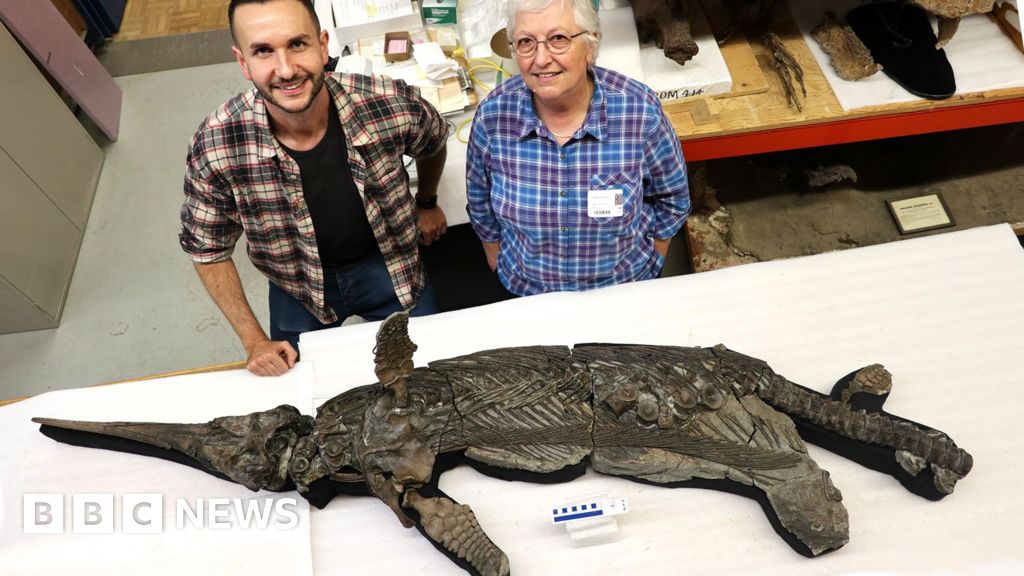 Jonah FisherEnvironment correspondent
Jonah FisherEnvironment correspondent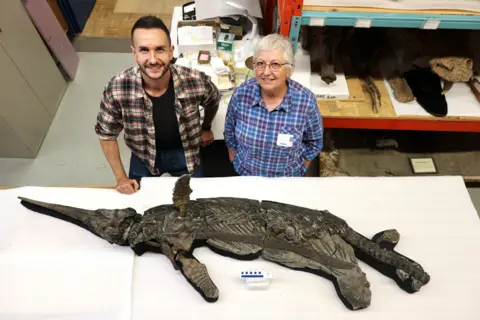 Dean Lomax
Dean LomaxA near-complete skeleton found on Dorset’s Jurassic coast has been identified as a new species of ichthyosaur, a type of prehistoric marine reptile that once ruled the oceans.
The dolphin-sized ichthyosaur has been named Xiphodracon goldencapensis, or the “sword dragon of Dorset” and is the only known example of its kind.
Scientists say that marks on its skull suggest that the “sword dragon” may have been killed by a bite to the head, possibly inflicted by a much larger species of ichthyosaur.
First discovered by a prolific fossil hunter at Golden Cap in Dorset in 2001 the new ichthyosaur was then acquired by a museum in Canada.
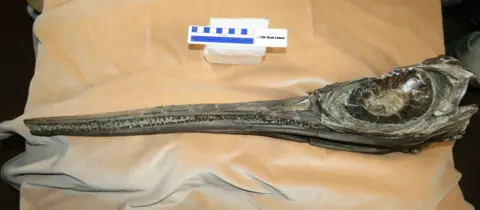 Dean Lomax
Dean LomaxIt has only recently been fully analysed by experts and a paper published identifying it as a new species of ichthyosaur.
“I thought long and hard about the name,” said ichthyosaur expert Dr Dean Lomax, who co-authored authored the paper identifying the skeleton as a new species.
“Xiphodracon translates to sword-like dragon and that is in reference to that very long, sword-like snout, but also the fact that ichthyosaurs have been referred to as sea dragons for about 200 years.”
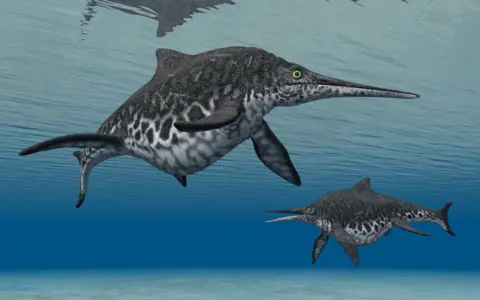 Getty Images
Getty ImagesIchthyosaurs are classified as marine reptiles, not dinosaurs, because they spent their lives in the water. This particular ichthyosaur is thought to have swum the seas about 185 million years ago, a period from which very few ichthyosaur fossils have been found.
“During this time ichthyosaurs are incredibly rare, and Xiphodracon is the most complete individual ever found from there, helping to fill a gap,” Dr Lomax said. “It’s a missing piece of the puzzle in the ichthyosaur evolution.”
The “sword dragon” is thought to have been about 3m long and has several features that have not been seen in other species of ichthyosaur. Scientists say the strangest detail is a prong-like bone near its nostril. The skull has an enormous eye socket and a long sword-like snout that it used to eat fish and squid.
There are also clues as to how this particular specimen lived and died.
“The limb bones and teeth are malformed in such a way that points to serious injury or disease while the animal was still alive, ” said study co-author Dr Erin Maxwell from the State Museum of Natural History Stuttgart.
“The skull appears to have been bitten by a large predator – likely another much larger species of ichthyosaur – giving us a cause of death for this individual. Life in the Mesozoic oceans was a dangerous prospect.”
The ‘sword dragon’ is one of numerous ichthyosaur fossils that have been found along Dorset’s Jurassic Coast since the first discoveries of pioneering palaeontologist Mary Anning in the early 1800s.
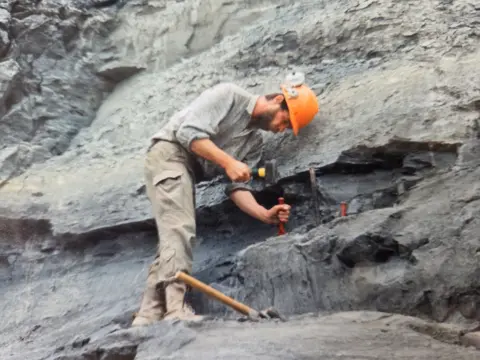 Chris Moore
Chris MooreThis “sword dragon” was discovered in 2001 by fossil hunter Chris Moore and then acquired by the Royal Ontario Museum in Canada where it took more than 15 years to be fully analysed.
“I don’t wish to blow my own ichthyosaur trumpet but I have found a few of them,” Mr Moore said on a video call from Dorset.
The actually number he’s unearthed is somewhere in the region of 15, with several of them, like the “sword dragon”, turning out to be new species.
Mr Moore says he is planning to celebrate the new discovery but has yet to decide exactly how.
“Champagne or a mug of tea, I’m not sure which yet,” he says.


